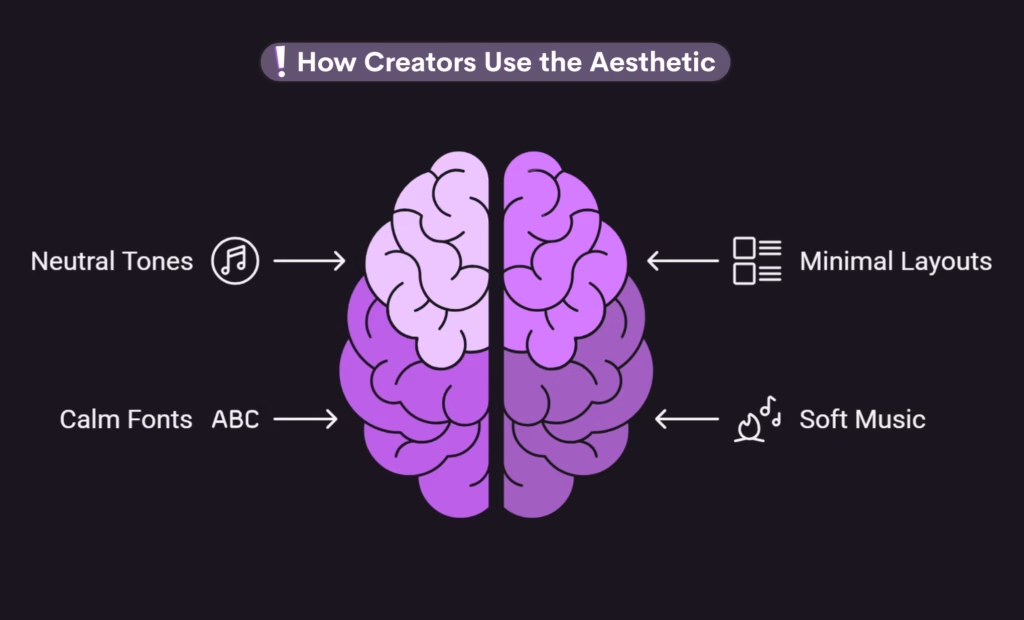- Why clean aesthetics feel safe, trustworthy, and addictive
- The emotional psychology behind the clean girl aesthetic trend
- How creators use visual tricks to make content more appealing
- How to enjoy these trends without falling into comparison traps
You Don’t Live Like That—But You Double Tap Anyway
You’re scrolling at 1 AM, and there it is again:
That familiar swirl of beige tones, a glass of green matcha, slicked-back hair, glowing skin, delicate gold jewelry, and a perfectly tidy room bathed in sunlight.
The clean girl aesthetic strikes again — and today, we’re diving into the clean girl aesthetic explained from a psychology perspective.
Even if you’re sitting there in your fluffy pajamas, surrounded by laundry and unfinished to-do lists, you still double tap. Maybe you save it too.
But why?
It’s not just pretty photos — this is psychology at play. Your brain LOVES these posts, and here’s exactly why.
Clean Girl Aesthetic Explained: It’s More Than a Look
The clean girl aesthetic isn’t just about skincare and matching workout sets—it’s a carefully curated feeling.
It’s Defined By:
- Minimal makeup (but glowy and fresh)
- Sleek hair—usually in a bun or ponytail
- Neutral clothing—think beige, white, black
- Gold jewelry—simple and timeless
- Calm, airy backgrounds—often with lots of white space
- Soft, smooth filters and gentle lighting
It represents minimalism, effortlessness, and soft luxury.
But underneath the neutral colors and polished feeds, there’s something much deeper happening.
Clean Girl Aesthetic Explained: Why Your Brain Trusts It
Here’s a brain fact for you: your mind LOVES clarity and ease.
That’s why these posts feel instantly calming and trustworthy.
This taps into a psychological phenomenon called the aesthetic-usability effect—when we see something that is well-organized and looks good, we automatically think it is better and more reliable.
Your brain interprets:
- Clean visuals = clarity = safe + trustworthy
- Soft colors + white space = emotional calm
- Minimal content = simplicity + control
These posts trigger instant dopamine because they’re easy to process and visually soothing.
It’s like digital chamomile tea for your brain.
Psst: I actually break down this exact design psychology trick in my article here. If you’ve ever paused mid-scroll just because a post looked pretty, this explains why!
Minimal Content = Emotional Safety
The real hook behind the clean girl aesthetic? Emotional safety.
You’re not really obsessed with their morning matcha or 6-step skincare routine.
You’re drawn to how their life feels—calm, soft, and in control.
These posts make your brain think:
- “This is what peace looks like.”
- “If I looked like this, maybe life would feel easier too.”
- “This person has it all together… maybe I could too.”
It’s not shallow—it’s a coping mechanism.
It’s hard to find calm and peace in a world full of noise and excitement, so we look for them anywhere we can, even on screens.
It’s a Projection, Not Reality (And That’s Okay)
Let’s be real: most of us aren’t living like those posts.
But here’s the truth—it doesn’t matter.
Psychologists call this symbolic self-completion. It’s when we collect symbols (like saved posts) to represent the person we aspire to be.
You’re not saving that slicked-back bun tutorial to follow it step by step tomorrow morning.
You’re saving it because it represents a version of yourself you’d like to feel connected to—calm, put-together, thriving.
It’s kind of like digital vision boarding without scissors and glue.
Creators Know This (And They Use It Intentionally)
Let’s not villainize the creators—many of them know exactly what they’re doing, but not in a malicious way.
They intentionally lean into this aesthetic by:
- Using neutral tones and soft lighting
- Creating minimal, clean layouts with plenty of white space
- Choosing fonts and captions that feel calm and friendly
- Pairing visuals with soft music or gentle voiceovers
It’s not necessarily to “trick” you—it’s simply using psychology to create an emotionally resonant experience.
Just like any other form of content design, it’s about crafting a vibe intentionally.

The Calm Scroll Trap (And How to Avoid It)
Here’s where it gets sneaky.
Because this aesthetic is so soothing, it’s easy to get stuck in a passive scroll loop—mindlessly consuming more and more posts that feel “good” but leave you feeling… weirdly drained after.
This is called the calm scroll trap—when we confuse digital calmness for actual relaxation.
Simple ways to avoid it:
- Pause after a few posts. Ask: “Am I feeling inspired or just numbed?”
- Actively engage. Comment or save with a purpose (like an idea for later).
- Balance with reality. Remind yourself: This is curated, not a full picture.
Craving more calm in your digital life?
I actually share more soothing psychology tips via my email list.
Bonus? You’ll instantly get my free Digital Detox ebook after subscribing!
Conclusion: You’re Not Shallow—You’re Just Wired Like This
Here’s the truth: You’re not weird or shallow for loving clean aesthetics.
You’re simply human.
Your brain is designed to seek beauty, simplicity, and emotional calm—especially online.
So next time you save a clean girl aesthetic post, just smile. Your brain is doing exactly what it’s built for.
Let it inspire you, but don’t let it define you. You’re already enough!
Frequently Asked Questions
The clean girl aesthetic is a minimalist, polished trend featuring glowy skin, slicked-back hair, neutral outfits, and soft, effortless beauty.
The clean girl mentality focuses on simplicity, wellness, and self-care—embracing minimalism, organization, and a calm, put-together lifestyle.
While no one really started it, the clean girl aesthetic grew popular through TikTok and Instagram, inspired by models, influencers, and soft luxury brands.
The anti clean girl aesthetic rejects minimalism, embracing bold colors, messy looks, maximalism, and authenticity over curated perfection.
The clean girl stereotype refers to someone who appears effortlessly flawless, with minimal makeup, sleek hair, and a “that girl” vibe focused on wellness and aesthetics.

